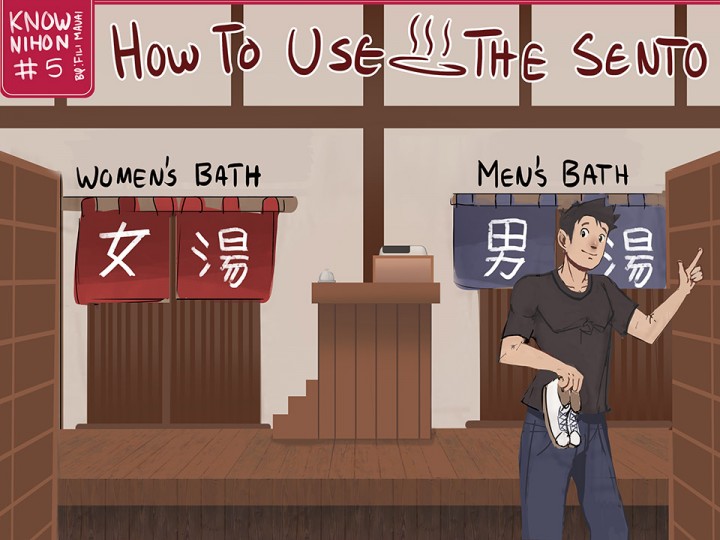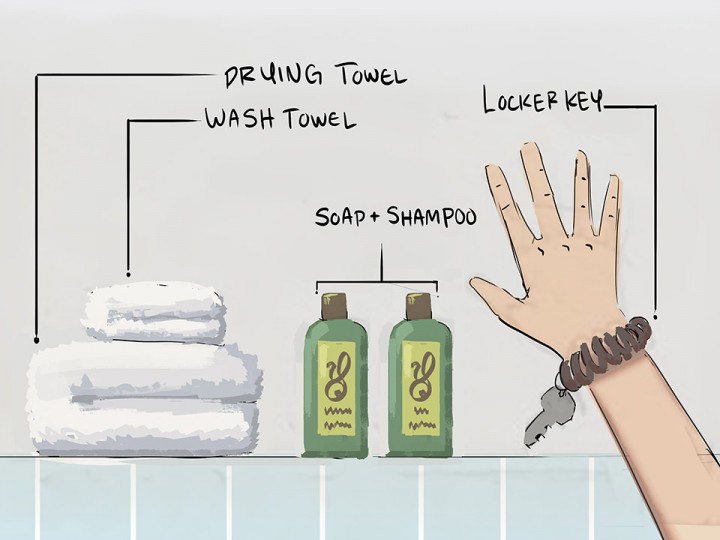- LEARN
- how-to manga
- HOW TO USE THE SENTO PUBLIC BATH
HOW TO USE THE SENTO PUBLIC BATH

• Remove your shoes and place them in the shoe rack. In traditional bathhouses, you might get a fun wooden key, but most modern sento use regular lockers nowadays.
• Pay the bathing fee: typically around 500 yen. Larger “Super Sento,” which offer additional amenities, cost anywhere from 1,000 to 3,000 yen.
• Enter the changing area corresponding to your gender—sento are always gender-segregated. Be careful to watch the signs because male (男) and female (女) baths may switch from time to time.

• In the changing area, remove all clothing and accessories. Bring only the essentials: your locker key, soap, shampoo, and a small wash towel. While soap is usually provided, some places do not offer shampoo or conditioner (you shouldn’t submerge your head in the bath, by the way).
• Some sento provide yukata robes for convenience, but in many cases, you will go to the bathing area completely nude. A small towel can be used for modesty if you prefer.

• Find an open space at a faucet, set down your items, and wash your body thoroughly while seated on one of the stools. Since many people share the bath, it’s essential to clean yourself well, especially private areas. Women should also remove makeup before entering.
• If you see personal belongings in front of a faucet, it means someone plans to return—choose an unoccupied spot instead.
* Wash your body thoroughly outside of the bath. Never wash yourself in the bath.

• Immerse yourself in the hot bath, ideally up to your neck. Some sento offer unique baths, such as electric current baths, aromatic baths, or baths with health benefits. If the water is too hot, a cooler bath is often available.

• After soaking, rinse off with hot water from a faucet before leaving the bathing area. Even though the bathwater is clean and hot enough to kill bacteria, Japanese bath culture values a final rinse—this practice is called kake-yu (掛け湯).
• Before re-entering the changing area, use your towel to dry off thoroughly. Keeping the changing room dry and tidy is a sign of good manners.
The Cultural Importance of Bathing
For the Japanese, bathing is more than just hygiene—it’s a ritual for relaxation and unwinding after a long day. Unlike the Western habit of morning showers, most Japanese prefer evening baths. That said, morning baths are becoming increasingly popular.
In the 1950s, the popularity of home baths led to a decline in public bathhouses. However, the charm of traditional sento with their spacious yubune (large bathtubs) and unique interiors continues to captivate younger Japanese and foreigners alike. The sento culture dates back to the Edo period (around 1840), when mixed-gender communal baths were common. Over time, these evolved into the gender-segregated sento of today. “Super sento,” large public bath complexes, offer modern amenities such as dining areas and game zones, while smaller neighborhood sento remain places of solitude for those seeking peace and tradition.
Other Important Information
• Japan is a safe country, but thefts do occasionally occur at bathhouses. To avoid problems, bring only the essentials: bathing items and a small amount of cash.
• Tattoos are still widely associated with criminal organizations in Japan. Many sento and onsen (hot springs) do not permit guests with tattoos. If you have small tattoos, you may be allowed in if you cover them with a bandage, but larger tattoos will likely prevent entry. However, in Suginami, Kosugi-yu in Koenji and Anshin Oyado (a men-only capsule hotel in Ogikubo) accept tattooed guests.
• Small children who are not potty-trained should not enter the bath. Women who are menstruating are also advised not to use the bath.
• Special sento bags, sold at cosmetic and specialty stores, make for a great souvenir!
[updated March 2025]
Illustrations: Fili Mauai
Text: K. Tezuka
Translation: Greg








